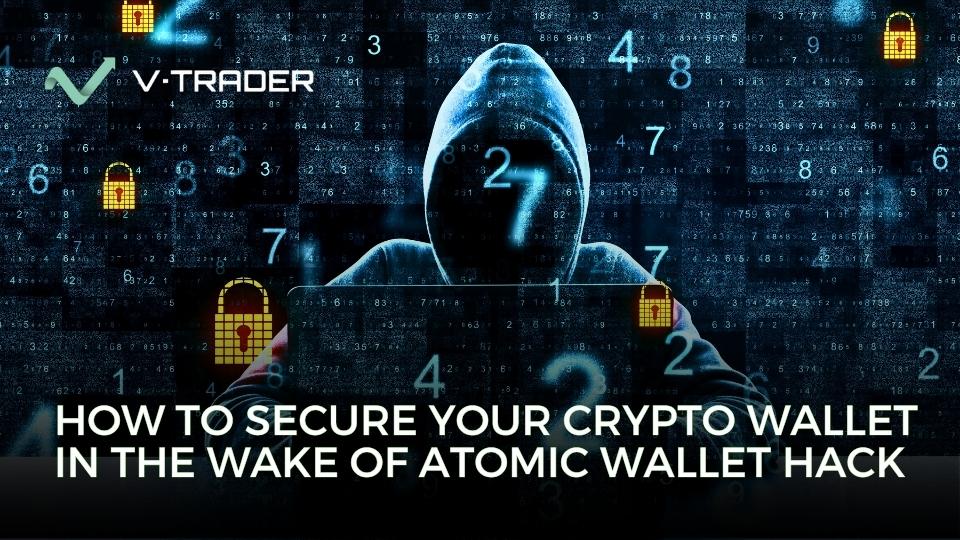In today’s digital world, knowing how to secure your crypto wallet is essential information. A crypto wallet stores your private keys, which are necessary to access and manage your cryptocurrency assets.
Whether you’re a seasoned trader or just starting out, securing your crypto wallet is the first line of defense against potential losses, hacks, and theft. The importance of robust wallet security is clear when considering recent high-profile breaches, such as the Atomic Wallet hack. In June 2023, it was reported that hackers compromised over $100 million worth of assets from users of this popular wallet. This event highlighted the ever-growing risk to crypto wallets and the urgency of taking proactive measures to protect your assets.
With crypto becoming a mainstream financial tool, users must understand the risks and adopt the necessary practices to protect their investments. This guide provides a comprehensive look at how to secure your crypto wallet, from the basics to advanced security techniques, to ensure that your digital assets stay safe.
Understanding Crypto Wallets
Before diving into security practices, it’s important to understand what a crypto wallet is and how it works. A crypto wallet is a digital tool used to store and manage cryptocurrencies like Bitcoin, Ethereum, and others. It contains a private key (or keys), which are necessary to access and transfer funds on the blockchain. Without the private key, you cannot access your assets.
Crypto wallets come in two main types: hot wallets and cold wallets.
- Hot wallets are connected to the internet and are more convenient for everyday transactions. However, because they are online, they are more vulnerable to cyberattacks.
- Cold wallets, on the other hand, are offline storage options, such as hardware wallets or paper wallets, which provide a higher level of security.
While hot wallets are ideal for frequent use, cold wallets are recommended for storing large amounts of cryptocurrency due to their enhanced security.
Key Security Risks and Vulnerabilities
Despite their usefulness, crypto wallets are vulnerable to several threats, making securing them crucial. Here are some of the most common risks:
- Phishing: Attackers use fake websites or emails to trick users into revealing their private keys, passwords, or recovery phrases. They often mimic legitimate platforms, such as wallet providers or exchanges.
- Malware: Malicious software designed to steal sensitive data. This can be particularly dangerous if malware infects a user’s computer or mobile device and monitors their crypto transactions.
- Keylogging: Cybercriminals may install keyloggers to record keystrokes on cell phones and personal computers, including passwords and private keys, when users log into their wallets or accounts.
- Human Errors: Many wallet losses result from simple mistakes, such as losing private keys or passwords, failing to back up recovery phrases, or storing sensitive information in insecure places.
The combination of digital vulnerabilities and human error creates a perfect storm for crypto theft, making proper security of your wallet more important than ever.
Essential Steps to Secure Your Crypto Wallet
Working with your crypto wallet begins with understanding the potential risks and taking proactive steps to protect yourself. Here are the most essential actions every user should take:
- Choosing a Reputable Wallet: The first step in securing your crypto assets is selecting a reliable and trusted wallet. Look for wallets that offer strong security features, such as multi-signature support, two-factor authentication (2FA), and regular software updates. Wallets like Ledger, Trezor, and Exodus are known for their security and user-friendly interfaces.
- Use Hardware Wallets for Significant Holdings: For larger amounts of crypto, hardware wallets provide the most secure storage option. These offline devices store private keys away from the internet, making them nearly immune to online threats like phishing and malware. Popular hardware wallets include Ledger Nano X and Trezor Model T.
- Enabling Two-Factor Authentication (2FA): Two-factor authentication (2FA) adds an extra layer of security by requiring not just your password but also a second factor, such as a code sent to your mobile device, to access your wallet. Enabling 2FA significantly reduces the likelihood of unauthorized access, especially if your password is compromised.
- Regularly Updating Wallet Software and Firmware: Sounds basic, right? Well, security vulnerabilities are regularly discovered in software, that’s why it’s critical to keep your wallet’s software and firmware up to date. These updates often contain security patches that address newly discovered threats.
- Securely Backing Up Private Keys and Seed Phrases: This is one of the most important steps in wallet security – backing up your private keys and seed phrases. These are essentially your crypto wallet’s lifeline. Write them down and store them in a secure place, preferably offline. Avoid storing them digitally on your computer or in cloud storage, as these can be hacked, lost, or stop working.
Advanced Security Practices
For those who are serious about protecting their digital assets, there are several advanced security practices to consider:
- Using Multi-Signature (Multi-Sig) Wallets: We spoke about this above, multi-signature wallets require more than one private key to authorize a transaction. This provides an extra layer of security, ensuring that even if one key is compromised, your assets remain safe. Multi-sig wallets are especially useful for businesses or joint accounts, where multiple people need to approve transactions.
- Implementing Hardware Security Modules (HSMs): Hardware security modules (HSMs) are physical devices that securely manage and store private keys. They are commonly used in enterprise-level crypto security but can also be used by individuals who want to protect their assets with the highest level of security.
- VPN and Secure Internet Connections: When conducting crypto transactions, it’s important to use a secure internet connection, such as a VPN (Virtual Private Network), to hide your IP address and encrypt your online activity. Public Wi-Fi networks are particularly vulnerable to hacking attempts, so it’s best to avoid them for crypto-related activities.
- Address Whitelisting and Transaction Limits: Whitelisting allows you to specify which addresses your wallet can send transactions to, adding yet another layer of control. Setting transaction limits can also help prevent unauthorized transfers in case your wallet is compromised.
Common Mistakes to Avoid
While securing your wallet is crucial, avoiding common mistakes is just as important:
- Storing Private Keys Digitally Without Encryption: Storing private keys on your computer or online without encryption is one of the biggest mistakes you can make. Always encrypt private keys if you must store them digitally.
- Sharing Wallet Details or Keys Publicly: Never share your private keys, seed phrases, or wallet passwords with anyone. Be cautious of sharing any sensitive wallet information on social media or forums, as scammers may be watching.
- Using Outdated or Unofficial Software: Always use official wallet software from reputable providers. Unofficial or outdated software may contain security vulnerabilities that can be exploited.
- Neglecting Wallet Backups and Recovery Phrases: Failing to back up your wallet or recovery phrases can result in losing access to your assets. Ensure that you back up your information and store it securely offline.
Control of Your Crypto Future: Secure Your Wallet Now
The value of your crypto holdings is not just a reflection of market trends, it’s a testament to your ability to safeguard what’s yours. Whether you rely on a hot wallet for day-to-day transactions or a cold wallet for long-term storage, employing strong security measures should be the focus of protecting your investments.
By adopting the strategies outlined above, choosing a reputable wallet, using physical hardware wallets for significant holdings, enabling two-factor authentication (2FA), and securely backing up your private keys, you take a giant step toward minimizing the risks of hacks and theft while holding crypto.
But securing your crypto wallet is not a one-time task, it’s an ongoing commitment. The world of digital assets offers vast potential, and with the right security measures in place, you can confidently seize these opportunities while keeping your assets safe.
For those looking to take their crypto journey to the next level, vTrader offers a platform designed with security at its core. With advanced tools, robust features, and a commitment to protecting your digital assets, vTrader ensures that you can trade with peace of mind. Explore vTrader today and secure your financial future in the world of crypto.

Steve Gregory is a lawyer in the United States who specializes in licensing for cryptocurrency companies and products. Steve began his career as an attorney in 2015 but made the switch to working in cryptocurrency full time shortly after joining the original team at Gemini Trust Company, an early cryptocurrency exchange based in New York City. Steve then joined CEX.io and was able to launch their regulated US-based cryptocurrency. Steve then went on to become the CEO at currency.com when he ran for four years and was able to lead currency.com to being fully acquired in 2025.




I know this website offers quality based posts and additional material, is there any other website which provides such data in quality?
I got this website from my buddy who shared with me regarding
this website and now this time I am visiting this web page and reading very informative articles at this time.
I got this website from my pal who informed me on the topic of this site and now this time I am browsing this website and reading very informative content at this time.
Thank you, I have just been searching for info approximately this
subject for ages and yours is the best I’ve found out till
now. However, what about the bottom line? Are you positive in regards to the source?
Pretty! This has been an incredibly wonderful article. Thanks for supplying these details.
I do believe all the ideas you’ve presented for your post.
They are really convincing and can definitely work.
Still, the posts are too quick for novices.
May just you please lengthen them a bit from subsequent time?
Thanks for the post.
whoah this weblog is great i like reading your posts. Stay up
the good work! You recognize, lots of persons are looking round for this information, you can help them
greatly.
It’s hard to find experienced people in this particular topic, but
you sound like you know what you’re talking about!
Thanks
Aw, this was an incredibly good post. Spending some time and actual effort to create a really good article… but
what can I say… I procrastinate a whole lot and don’t manage to get anything done.
When someone writes an paragraph he/she maintains the
image of a user in his/her mind that how a user can know it.
Therefore that’s why this piece of writing is outstdanding.
Thanks!
A person essentially assist to make critically articles I might state.
That is the first time I frequented your web page
and up to now? I amazed with the analysis you made to make this actual post amazing.
Wonderful job!
Thanks for a marvelous posting! I quite enjoyed reading it, you could be a great author.I will make sure to bookmark your blog
and will come back sometime soon. I want to encourage you continue your great
posts, have a nice afternoon!
A motivating discussion is worth comment. There’s no
doubt that that you should publish more about this topic, it might
not be a taboo matter but typically people
don’t discuss such topics. To the next! All the best!!
I like what you guys are up too. This type of clever work and coverage!
Keep up the very good works guys I’ve you guys to my own blogroll.
After looking over a number of the articles on your blog, I
honestly like your way of writing a blog. I bookmarked
it to my bookmark webpage list and will be checking back in the near future.
Please visit my website as well and tell me what you think.
I think the admin of this site is actually working hard
in favor of his site, since here every material is quality based data.